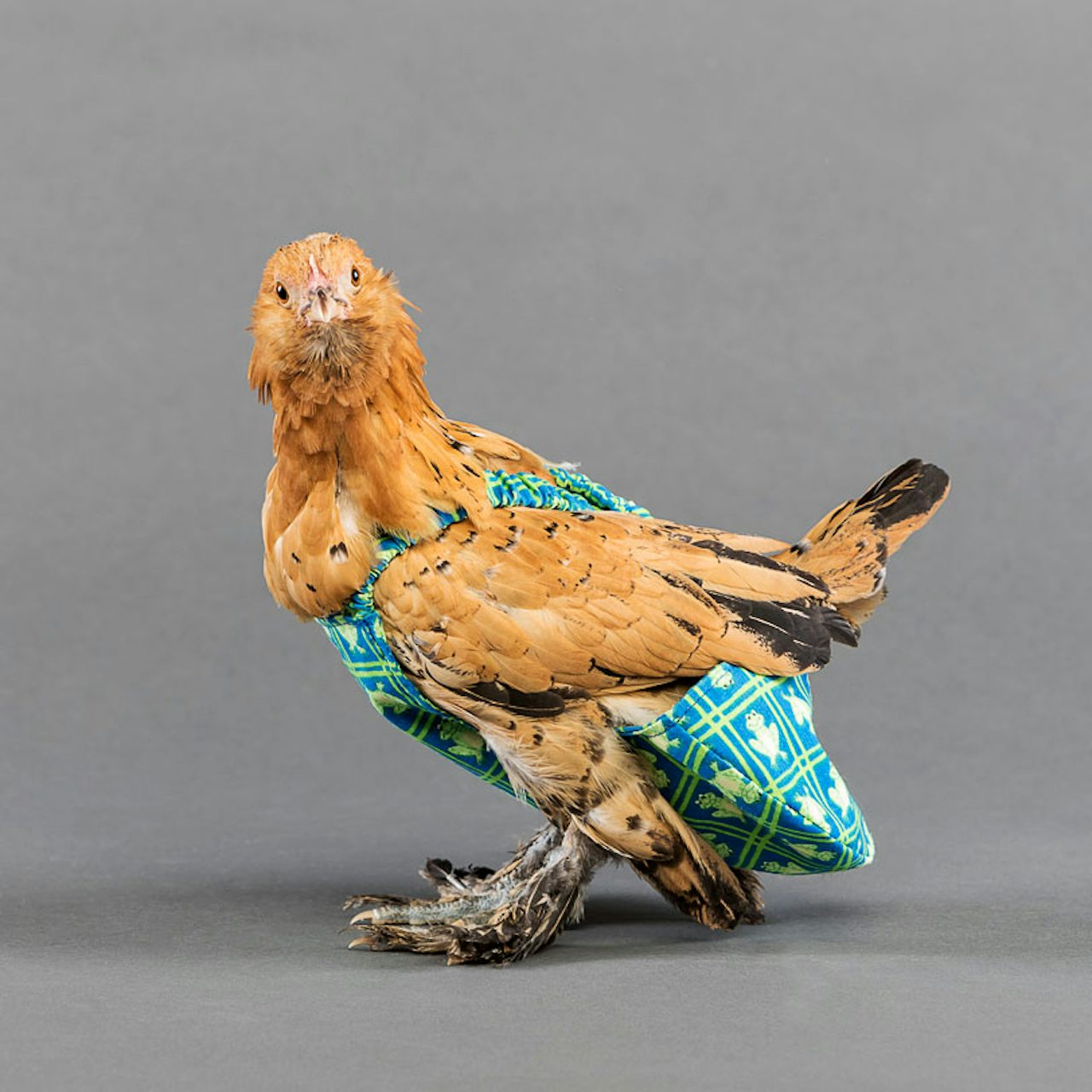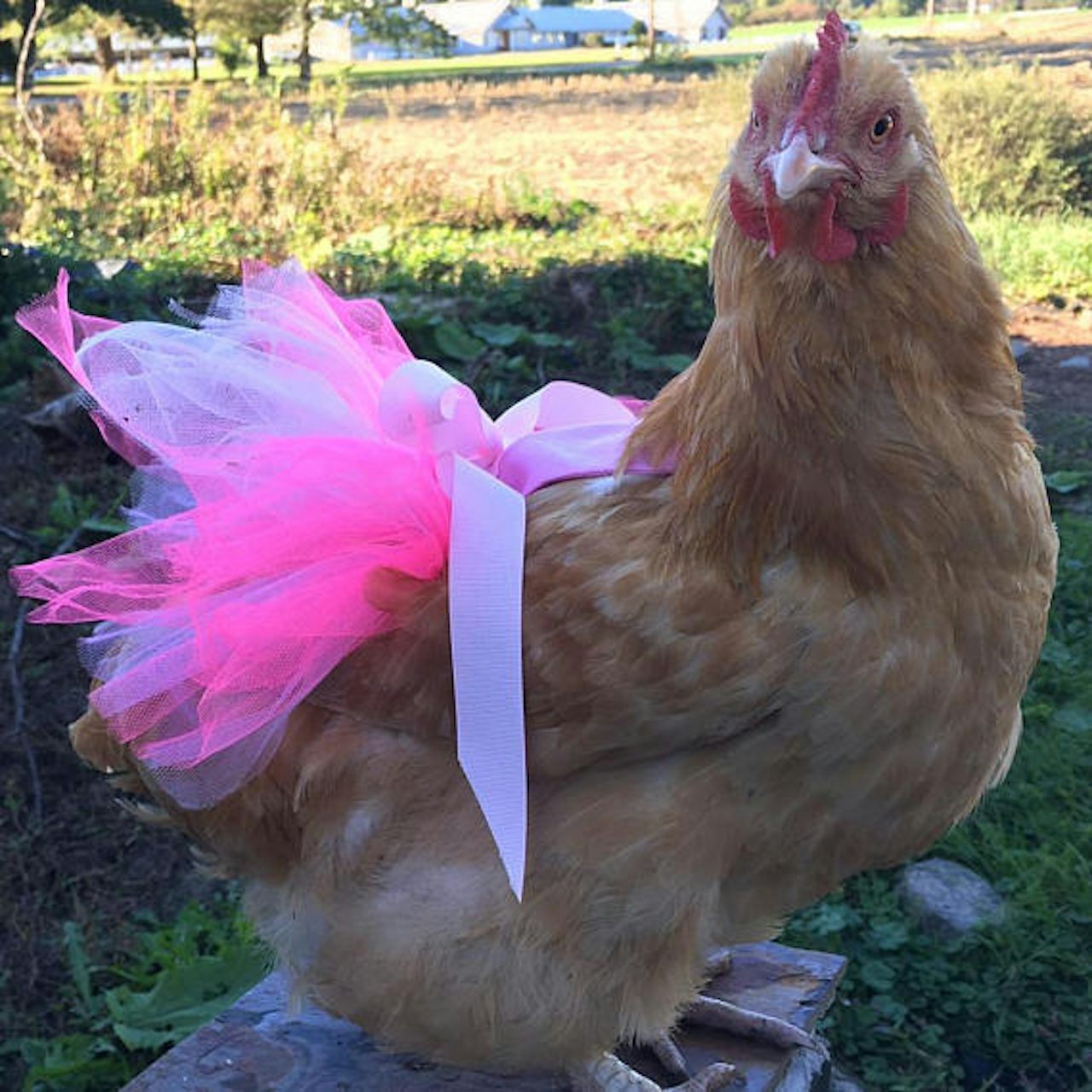Julie Baker never intended to become a figurehead of the luxury chicken-diaper industry. Before she launched her brand Pampered Poultry in 2010, she had never even heard of chicken diapers.
Around 10 years ago, Baker was raising chickens with her daughter on their small farm in Claremont, New Hampshire when she first saw a YouTube video of a chicken wearing what looked to be an upside-down apron that stretched across its backside. The diaper, so to speak, was used to catch chicken poop so the birds wouldn’t leave droppings everywhere (chickens do not urinate separately from defecation. Their urine is technically in their excrement). “I'm like, ‘Oh my goodness, I so need to do that,’” Baker said. Baker’s daughter liked to bring her favorite chicken, an Old English hen named Abigail, inside their house, and because chickens poop close to a dozen times per day, Baker needed a better system for managing Abigail’s excrement.
So she began sewing Abigail diapers out of cotton fabric, and soon other poultry owners asked if Baker could make diapers for their chickens, too. Baker, who was homeschooling her daughter at the time, decided to turn the task into an assignment — she and her daughter would launch an online store. Not because she thought anyone would visit, but because she thought it would be an informative experience.
Then Baker started getting orders. Lots of them. Though at first she was mainly selling to her friends who attended poultry shows — to the true chicken die-hards who also like to enter their birds into pseudo-relay-races — in the last few years she’s noticed a shift in her customer base. Even people without deep connections to the poultry world want her diapers so they can take their chickens indoors (and post stylish photos on Instagram). Baker currently sells 500 to 1,000 diapers, which retail for $18 apiece, each month. “There's not a single state that I don't ship to,” Baker said.
Over the last decade, raising chickens — once the domain of rural farmers who would house flocks of hundreds of chickens on their property — has become an elite hobby. Nearly 1 percent of households in the country’s biggest urban areas, like New York, Denver, and Los Angeles, keep chickens, according to a 2013 Department of Agriculture study. These urban and suburban hobby farmers are bringing their chickens into their homes, buying them speciality food, and taking them for walks with their dogs.
In wealthy cities like San Francisco, chickens have even become an unlikely status symbol, with poultry owners going to unimaginable lengths to care for their pets. As The Washington Post reported in March, certain chicken owners have hired “chicken whisperers” to consult on their pets’ comfort (to the tune of $225 per hour). These nouveau livestock enthusiasts have also been known to invest in personal chefs for their birds, and some have even installed smartphone-enabled, motion-detecting coops that control ventilation, temperature, lighting, and security from afar (ballpark cost: $20,000).
“We spend an insane amount of money. We thought we’d feed them leftovers, but our chickens end up eating grilled salmon, steak, fresh lettuce and organic watermelon,” one chicken owner, Amina Azhar-Graham, told the Post.
And where indoor chickens go, diapers follow. Some chickens can be housebroken, but such is not an easy task, leaving poultry parents in densely populated areas to have to find ways to take care of the inevitable.
Chicken diapers work differently depending on the brand. Connecticut resident Traci Torres, the owner of My Pet Chicken, said that some of her diapers have velcroed-in liners that owners remove once soiled — usually around two to three times per day — and then replace with another liner. Other diapers are moisture-resistant, so that owners can simply remove the whole diaper, wipe out the excreta, and throw it in the wash. Other diapers are more lo-fi, recommending that a person place a paper towel inside the diaper and simply remove it once sullied. Most chicken diapers are machine washable and intended to endure for months (the industry is nothing if not sustainable).
Pampered Poultry pricepoint of $18 per diaper is fairly standard. Purely Poultry’s zebra, daisy, and pink camo designs go for around $17, while My Pet Chicken offers custom-made diapers for $30. FeatherWear retails their denim “FlockSuits” — premium diapers that are pitched as “Levi Strauss meets Calvin Klein” for nearly $38.
“The market is enormous and there’s lots of competition,” Traci Torres, the owner of My Pet Chicken, told The Outline.
Torres sold her first diaper in December 2007 after she kept getting phone calls out of the blue requesting them. Though Torres designs most of the diapers herself, she hired a seamstress to start sewing them; she estimates that she’s sold more than 5,000 diapers.
Baker has begun selling another upscale chicken accessory, this one without much of a function — the chicken dress. She currently offers $15 blue-or-purple tutus alongside more upscale nightgowns marketed “for the fashion-conscious hen.” Baker estimates that chicken dresses comprise 10 percent of her business, amounting to about 100 dresses sold per month. “You [used to] put a dress on your chihuahua. Now people are putting a dress on their chicken,” Baker said.
Well-dressed chickens have become an Instagram staple. The Drinking with Chickens account (44,000 followers) features a variety of chickens posing in ponchos and flower crowns alongside alcoholic beverages, while the Austin-based Instagram user cluckingchic (5,500 followers) has adorned her chickens with Pride-themed bowties.
To Baker, the growth of the luxury chicken industry tracks with shifting attitudes toward the bird. For centuries, chickens were seen as dirty, replaceable livestock — they were rarely named, and if they got sick, they would usually just be culled.
“Over the last couple of years, it has changed to people actually calling their chickens pets,” Baker said. “When I first started, I reached out to some of the vets and said, 'Hey, if people are bringing in sick birds, maybe you would like to offer them a chicken diaper to go home with,' and they just laughed at me. [They said,] ‘We're not going to vet a chicken, that's insane.’ If a chicken is sick, you chop its head off, basically. And now there are whole vets that specialize in chickens."
Most of Baker’s customers are still in the backyard-chicken business, meaning they keep small, outdoor flocks of fewer than 20 chickens, but increasingly her customers own just one or two chickens that they keep in their small houses or apartments. “I ship to New York City all the time,” Baker said. “And every time I get a New York, New York shipping address, I'm like, ‘Well, this has got to be an apartment chicken.’”
Even classic chicken accessories now have luxury counterparts. For instance, chicken saddles, which drape across a chicken’s back to protect its feathers during mating, have existed in since 1910, but now store owners like Torres are selling colorful, polka-dotted upgrades (starting at $22.95).
In the course of reporting this piece, The Outline contacted nearly a dozen chicken-diaper and-saddle vendors to ask about their sales figures. The numbers ranged from a dozen per year to nearly ten thousand — Colorado-based Chicken Armor, for instance, has sold around 50,000 saddles since its launch in 2011.
But even Baker doesn’t think any of this would have happened if chicken owners weren’t so eager to dress their pets up for social media photo shoots (or enroll them in the University of Mississippi).
“I think it's totally a way to just make your Facebook page look funny and cool. It's a way to get a lot of instant likes on Instagram,” Baker said. People drape their chickens in dresses for the same reason they force their dogs into clothing, she said. “It's a way to include them in your activities. [On] the Fourth of July, it's fun to dress them up in patriotic stuff and have pictures of them at your picnic.”
When I asked about the utility of her chicken dresses, assuming that, like chicken diapers, they must do something of merit, Baker laughed. “They literally are chicken tutus,” she said. “They are not diapers. They serve absolutely no purpose. Literally, no purpose, other than to look cute. They're ridiculous.”


